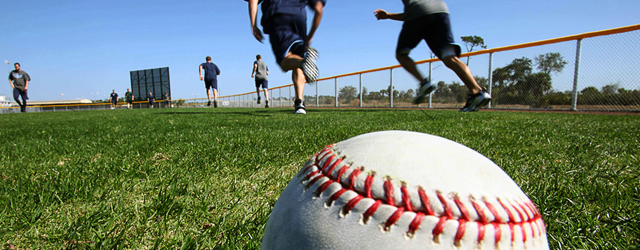
Only a few days left in our 21 Days to Building a Better Ballplayer challenge. Today’s task is to start conditioning more effectively. To keep it simple, stop running long distance and start incorporating sprint work into your conditioning.
Breaking Old Habits (and Older Traditions)
Run – that’s what athletes do. No matter what sport you play, at some point in your athletic career you will run. Long distance, sprints, intervals, gassers, suicides. You name, you’ll run it. For baseball players and coaches, there has always been a tradition to run longer distances. At the beginning of the off-season, coaches will typically try to gauge their players’ fitness by having them run 1.5-2 miles. Then “re-test” them closer to the season to see if they have improved. In-season conditioning for pitchers usually consists of poles or other long distance runs between outings. Then, there is always the conditioning for punishment because the team screwed up off the field or has been on a losing streak. (Now, that’s just dumb.)
But, not all forms of conditioning are created equal. Though baseball has come a long way in terms of accepting strength training, soft tissue work, and mobility training as valid forms of preparing players for the game, some coaches are still stuck on long distance running as a valid form of conditioning. Why? I do not know the exact answer, but my experience with the game tells me it could be because of a number of reasons: tradition, lack of knowledge, laziness, or all three.
Baseball is an Explosive Sport
To really address this issue, let’s look at the game itself and how it is played. The pitcher makes a pitch than takes about 4-5 seconds to execute. Then he has about 30-60 seconds before he delivers another pitch. If the hitter makes contact and puts the ball in play, it takes him 4-5 seconds waiting on the pitch, less than a second to complete his swing, and another 4-5 seconds to run 90 feet to first. At the most, that’s a total of 11 seconds if it’s a routine ground ball to complete the play from delivery of the pitch to the runner touching first base. And then, there is roughly 1-2 minutes of non-action before another pitch is thrown. Where in that scenario is any player on the field exerting himself over a long distance?
Baseball is a power-based sport. Most action on the field occurs quickly, with bursts of acceleration and top speed followed by long periods of rest. If a coach wants to condition his team, he should look to mimic the demands of the sport. Incorporating long distance running does not come close to this. In a long distance run, an athlete will exert himself at a moderate intensity over a long duration, and as a result, train his body to operate at a slower pace. The human body is an amazing machine that adapts well to the environment it is placed in. Train slow be slow. Train fast, be fast. I know you have heard the cliché before, but it rings true here.
If you want to be quick and explosive, you need to train that way. When it comes to conditioning, that means incorporating sprint work, sled pushes, medicine ball circuits, and any other form of power-based movements you can think of. Don’t forget about the rest intervals as well. In a sport where you can achieve nearly full recovery before you make another pitch, take another swing, or advance to the next base, you should be taking adequate rest between bouts of sprints or other conditioning sets.
Let’s make today’s task as simple as possible. Take out the guess work and just substitute some solid sprint work for your long distance running. Here’s a sample conditioning session you can try after you complete a solid dynamic warm-up or at the end of practice.
- 2 20-yard sprints at 75% effort
- 2 40-yard sprints at full effort
- 4 60-yard build up sprints – first 30 yards at 75% effort, second 30 yards at full effort
- 2 40-yard sprints at full effort
- 2 20-yard sprints at full effort
Walk back to the starting line after completing each sprint. The walk back is your rest and should be adequate enough to recover before the next sprint. When you return to the line, start your next sprint.
Good luck!

Leave a Reply